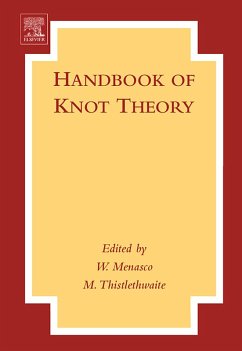This book is a survey of current topics in the mathematical theory of knots. For a mathematician, a knot is a closed loop in 3-dimensional space: imagine knotting an extension cord and then closing it up by inserting its plug into its outlet. Knot theory is of central importance in pure and applied mathematics, as it stands at a crossroads of topology, combinatorics, algebra, mathematical physics and biochemistry.
* Survey of mathematical knot theory
* Articles by leading world authorities
* Clear exposition, not over-technical
* Accessible to readers with undergraduate background in mathematics
* Survey of mathematical knot theory
* Articles by leading world authorities
* Clear exposition, not over-technical
* Accessible to readers with undergraduate background in mathematics
Dieser Download kann aus rechtlichen Gründen nur mit Rechnungsadresse in A, B, BG, CY, CZ, D, DK, EW, E, FIN, F, GR, HR, H, IRL, I, LT, L, LR, M, NL, PL, P, R, S, SLO, SK ausgeliefert werden.
CHOICE - September 2006
Handbook of Knot Theory, ed. By William Menasco and Morwen Thistlethwaite. Elsevier, 2005. 492 p bibl indexes ISBN 044451452X, $138.00
"Another title, perhaps "Surveys of Recent Advances in Knot Theory? might better suit this book. "Handbook? suggests, say, tabulations of those knots with few crossings in various classes, listed with their properties and invariants, everything supplemented by specifications of useful algorithms and key theorems that capture such regularities as emerge from all the data. But the era of such a handbook has passed. Indeed, the chapter by J. Hoste describes the state of the art concerning know enumeration. Although we lack an efficient, general recognition algorithm, existing techniques will classify the billions of distinct knots up to 20 crossings, and the mere dissemination of the results requires digital means and ingenuity. Other chapters will also immediately invite undergraduates, especially chapters by J.S. Burman and T.E. Brendle on braids, and L.H. Kauffman on knot diagrammatics. Overall, the ten chapters represent distinct views of the subject by some of its leading experts. More advanced students may read chapters by C. Adams and J. Weeks about hyperbolic (complements of) knots for an excellent entrée into Thurston's geometrization program, or chapters G. Friedman and C. Livingston about spheres knotting in four-dimensional space, an intriguing topic rarely treated outside the journal literature. SUMMING UP: Highly recommended. General readers; lower-division undergraduates through professionals." --D.V. Feldman, University of New Hampshire
Handbook of Knot Theory, ed. By William Menasco and Morwen Thistlethwaite. Elsevier, 2005. 492 p bibl indexes ISBN 044451452X, $138.00
"Another title, perhaps "Surveys of Recent Advances in Knot Theory? might better suit this book. "Handbook? suggests, say, tabulations of those knots with few crossings in various classes, listed with their properties and invariants, everything supplemented by specifications of useful algorithms and key theorems that capture such regularities as emerge from all the data. But the era of such a handbook has passed. Indeed, the chapter by J. Hoste describes the state of the art concerning know enumeration. Although we lack an efficient, general recognition algorithm, existing techniques will classify the billions of distinct knots up to 20 crossings, and the mere dissemination of the results requires digital means and ingenuity. Other chapters will also immediately invite undergraduates, especially chapters by J.S. Burman and T.E. Brendle on braids, and L.H. Kauffman on knot diagrammatics. Overall, the ten chapters represent distinct views of the subject by some of its leading experts. More advanced students may read chapters by C. Adams and J. Weeks about hyperbolic (complements of) knots for an excellent entrée into Thurston's geometrization program, or chapters G. Friedman and C. Livingston about spheres knotting in four-dimensional space, an intriguing topic rarely treated outside the journal literature. SUMMING UP: Highly recommended. General readers; lower-division undergraduates through professionals." --D.V. Feldman, University of New Hampshire


